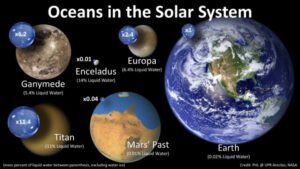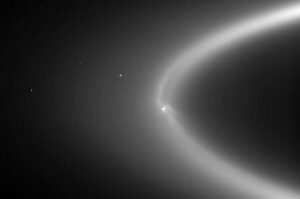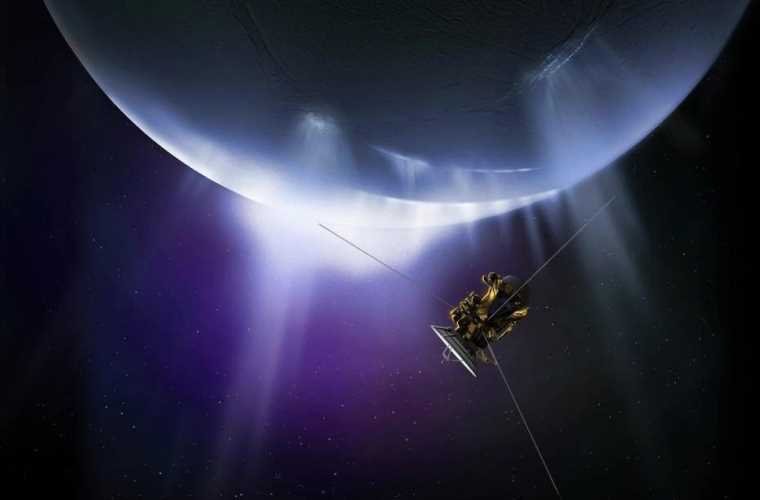An analysis of the massive plume of seawater erupting into space from Saturn’s moon Enceladus has revealed the presence of organic phosphates in the enormous subsurface ocean residing beneath the moon’s icy exterior.
Along with previous findings of other organic compounds key to life on Earth, this latest discovery means that all six elements considered crucial for life as we know it has been found in Enceladus’ sub-surface ocean. If confirmed, this finding dramatically increases the chances that life, including complex forms of life, maybe residing within or cosmic backyard.
Enceladus’ SubSurface Ocean Was Already an Enticing Target in The Search for ET
Before its demise in 2017, NASA’s Cassini probe found something extraordinary while surveying Saturn and its moons, signs that the icy moon Enceladus may have a massive subsurface ocean. This discovery was made due to the fact that Cassini spotted a huge plume of what appeared to be seawater spewing into space through cracks in the 12-mile-thick ice sheet that covers Enceladus. A similar plume shooting 6,000 miles into space was spotted by the James Webb Telescope just last month.
Follow-up observations of the Cassini data confirmed the finding, leading researchers to wonder if there may be life, including rather complex forms of life, living in this subsurface ocean.
More research followed, including chemical analysis of the plumes using light spectra data to determine the composition of the seawater blasting thousands of miles into space. Those studies found five of the six elements needed for complex life to exist on Earth, namely carbon, hydrogen, nitrogen, oxygen, and sulfur. Although the latter is still not completely confirmed, the findings offered increasing hope that there may indeed be life on, or more appropriately, inside Enceladus.
Now, new research says that the sixth and final element, phosphorus, has also been found, meaning the icy moon has met what some scientists describe as the “strictest requirements for habitability.”


Detection of Phosphates Means Even Complex Lifeforms May Be Swimming In Enceladus’ Ocean
“Phosphorus is an element essential for planetary habitability, but to date, it has not been detected in an ocean beyond Earth,” the researchers behind the tantalizing new finding write. “Previous geochemical modeling suggested that phosphate might be scarce in the ocean of Enceladus and other icy ocean worlds.”
Somewhat surprisingly, the team says that the initial readings indicate that not only are there phosphates in the moon of Enceladus, but they may be as much as 100 times the organic compounds found here on Earth.
To make this determination, the research team, which was led by planetary scientist Frank Postberg of the Free University of Berlin in Germany, used data collected from Cassini’s Cosmic Dust Analyzer instrument. That data was gathered by Cassini back in 2017, right before it plunged to its death into the atmosphere of Saturn.
Specifically, Cassini sampled the light spectra from Saturn’s second outermost ring, known as the “E ring,” which is mostly made up of the water spewed from Enceladus, creating a glowing hallow of vapor housing the icy moon.
From that data, Postberg and colleagues analyzed the spectral signature of 345 different particles. To their surprise, they found that nine of those particles contained the chemical signature of sodium phosphate, which is a chemical compound made up of sodium and phosphorus.
“In this work, we present CDA mass spectra of a population of E-ring ice grains that show the presence of sodium phosphates,” the researchers explained. “We then perform laboratory analog experiments to quantitatively establish that Enceladus’s ocean is rich in dissolved phosphate.”


Those lab experiments involved firing a laser into water that contained dissolved sodium orthophosphate and disodium hydrogen phosphate. As they hoped, the chemical “fingerprint” revealing the presence of the phosphates was identical to the signal they found in the data from Cassini.
Even more tantalizing, the analysis showed that the volume of phosphates on Enceladus could be as much as 100 times that found on Earth, dramatically increasing the chances that life in the oceans would have more than enough organic material to support more complex life forms like fish or even cephalopods, aka squids and octopi.
It’s Probably Time to Send a Probe to Scour the Oceans of Enceladus for Life
While further analysis is likely needed to confirm the finding of phosphates and the previous finding of sulfur, such confirmation would likely mean that it is time to send a probe to Enceladus to search for signs of extraterrestrial life.
One NASA proposal includes flying a probe through the vapor plumes ejected into space and collecting samples of material to return to Earth for closer study. Still, such an effort would likely only be able to reveal signs of microscopic life forms in the subsurface ocean.
While such a finding would be groundbreaking, the possibility that even more complex forms of life may be swimming around so close to Earth, at least cosmically, makes it even more tempting to try to develop a probe to drill through the icy crust and take a peek inside.
It is a challenging endeavor and likely still years away, but given this latest research and the growing body of evidence for life in the ocean of Enceladus, it may simply be time to start planning for just such an excursion.
Christopher Plain is a Science Fiction and Fantasy novelist and Head Science Writer at The Debrief. Follow and connect with him on Twitter, learn about his books at plainfiction.com, or email him directly at christopher@thedebrief.org.

